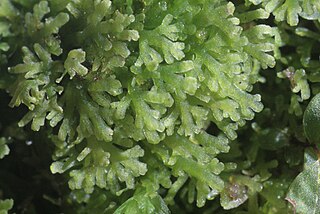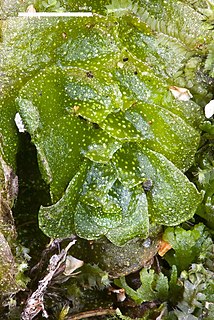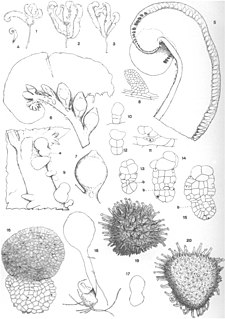
The Marchantiophyta are a division of non-vascular land plants commonly referred to as hepatics or liverworts. Like mosses and hornworts, they have a gametophyte-dominant life cycle, in which cells of the plant carry only a single set of genetic information.

Hornworts are a group of bryophytes constituting the division Anthocerotophyta. The common name refers to the elongated horn-like structure, which is the sporophyte. As in mosses and liverworts, the flattened, green plant body of a hornwort is the gametophyte plant.

Marchantiales is an order of thallose liverworts that includes species like Marchantia polymorpha, a widespread plant often found beside rivers, and Lunularia cruciata, a common and often troublesome weed in moist, temperate gardens and greenhouses.

Metzgeriales is an order of liverworts. The group is sometimes called the simple thalloid liverworts: "thalloid" because the members lack structures resembling stems or leaves, and "simple" because their tissues are thin and relatively undifferentiated. All species in the order have a small gametophyte stage and a smaller, relatively short-lived, spore-bearing stage. Although these plants are almost entirely restricted to regions with high humidity or readily available moisture, the group as a whole is widely distributed, and occurs on every continent except Antarctica.

Jungermanniopsida is the largest of three classes within the division Marchantiophyta (liverworts).

Cavicularia densa is the only species in the liverwort genus Cavicularia. The species was first described in 1897 by Franz Stephani, and is endemic to Japan, where it grows on fine moist soil.

Haplomitriopsida is a newly recognized class of liverworts comprising fifteen species in three genera. Recent cladistic analyses of nuclear, mitochondrial, and plastid gene sequences place this monophyletic group as the basal sister group to all other liverworts. The group thus provides a unique insight into the early evolution of liverworts in particular and of land plants in general.

Blasiales is an order of liverworts with a single living family and two species. The order has traditionally been classified among the Metzgeriales, but molecular cladistics suggests a placement at the base of the Marchantiopsida.
Apotreubia is a genus of liverworts in the family Treubiaceae. There are four species, including: Apotreubia nana, which is found in subalpine New Guinea, and Apotreubia pusilla, which has a disjunct distribution between eastern Asia and British Columbia.

Treubia is a genus of liverworts in the family Treubiaceae. There are seven species, all of which are restricted to the southern hemisphere. Five of the species occur in Australasia and the other occurs in Chile. All species are dioicous, with separate male and female gametophytes.
Colura zoophaga is a species of epiphytic liverwort that is endemic to the African highlands, specifically parts of Kenya. It belongs to the genus Colura, which has been hypothesized to be carnivorous as early as 1893. It is a recently described species that was the subject of the first scientific study aimed at investigating the allegations of carnivory in liverworts.
Colura is a genus of epiphytic liverworts and consists of approximately 60 species that are distributed mostly in the tropics. Species in this genus are no larger than a couple millimetres in size and may possess small water sac organs formed from fused leaf margins that trap small ciliates. It is because of this trapping mechanism that some species have been suspected of carnivory, even as early as 1893. One such species, Colura zoophaga, was the subject of a study that aimed to investigate the assumed carnivorous habit among liverworts. The results confirmed that ciliates were captured and died within the water sac traps, which are not unlike the bladder traps of Utricularia. Whether the species attract, digest, or absorb the prey has not been confirmed, however. The epiphytic habit of the genus, requiring all nutrients to be acquired from rainwater, is similar to the habit of known carnivorous plants.
Makinoa crispata is the only species of liverwort in the genus Makinoa and family Makinoaceae. The genus Verdoornia was formerly included in this family, but has been transferred to the family Aneuraceae on the basis of recent cladistic analysis of genetic sequences.

Ptilidium is a genus of liverwort, and is the only genus in family Ptilidiaceae. It includes only three species: Ptilidium californicum, Ptilidium ciliare, and Ptilidium pulcherrimum. The genus is distributed throughout the arctic and subarctic, with disjunct populations in New Zealand and Tierra del Fuego. Molecular analysis suggests that the genus has few close relatives and diverged from other leafy liverworts early in their evolution.
Neotrichocoleaceae is a family of liverworts in order Jungermanniales. It is closely related to the genera Ptilidium and Herzogianthus.

Riella is a genus in the liverwort family Riellaceae, and includes about eighteen species. Plants in the genus are small and grow submerged in shallow temporary pools. Although the genus is widely distributed in the Northern Hemisphere, locating populations is often difficult. Its occurrence is sporadic and local, and the tiny plants are ephemeral. The ornamented spores remain viable for several years, allowing the plants to survive annual drying of their habitat. The plants are easily grown in laboratory cultures.
Asterella gracilis is a thallose liverwort in the family Aytoniaceae.
Petalophyllum, or petalwort, is a genus of liverworts in the order Fossombroniales.

Ricciocarpos natans is the only species in the genus Ricciocarpos, a genus of liverworts in the family Ricciaceae. It was formerly listed in 1759 as a species of Riccia by Linnaeus, but then assigned to a new genus of its own in 1829 by August Carl Joseph Corda.
Cleveaceae is a family of liverworts belonging to the order Marchantiales.












